Summer has finally arrived! TODAY is the June solstice, while Earth’s North Pole is closest to the Sun
After weeks of gloomy weather, it won’t just be pagans celebrating the arrival of summer today.
Today’s summer solstice will give Britons their longest day of the year and shortest night, with a whopping 16 hours and 38 minutes of daylight in London.
At 21:51 BST tonight the Northern Hemisphere will be most tilted towards the Sun, marking the exact peak of astronomical summer.
But this year, summer has arrived almost a full day earlier, and today marks the earliest solstice since 1796.
But unfortunately the experts say this won’t give us an extra day of summer.
The summer solstice – when the Earth’s pole is most tilted towards the sun – marks the height of astrological summer and will give Britain the longest day of the year
As the Earth revolves around the sun in its annual cycle, it also rotates on its axis, exposing different parts to sunlight – creating the cycle of days and nights.
If the Earth’s axis were perpendicular to the sun’s rays, each part of the planet would get 12 hours of day and 12 hours of night.
Of course, the Earth does not revolve around the sun in this way, but is actually tilted on its axis.
Dr. Daniel Bayliss of Warwick University says: ‘Most planets have some tilt relative to their orbits around the sun.
‘Earth’s tilt is likely due to large collisions that hit the young Earth as it formed in the early solar system.’
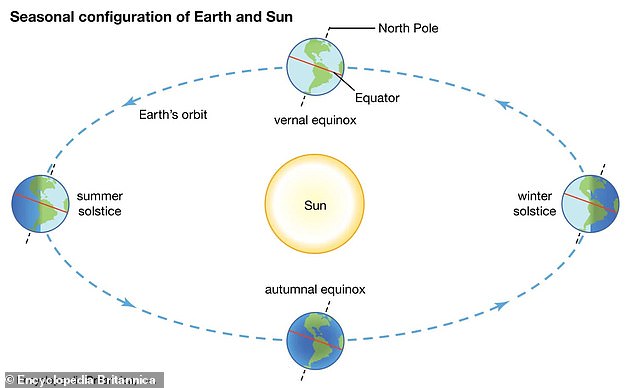
The solstice is the moment when the Earth is at its maximum tilt toward the sun, exposing the Northern Hemisphere to sunlight for a greater portion of the Earth’s rotation.
It is this tilt that gives Earth the regular progression of the seasons and creates the solstice.
Jack Foster, an astronomer at the Royal Observatory Greenwich, told MailOnline: ‘Our planet is tilted on its axis at an angle of 23.4 degrees, and as it orbits the sun the northern hemisphere is sometimes tilted towards the sun and sometimes it is tilted away. .’
This means that different parts of the planet receive different amounts of daylight during different parts of the year.
When the Northern Hemisphere is tilted toward the sun in summer, we are exposed to daylight for more of the Earth’s rotation.
Likewise, in winter, when the Northern Hemisphere moves away from the sun, our days become shorter because we spend less time exposed to the sun.
This is why regions within the Arctic Circle have 24 hours of daylight in some parts of the year and 24 hours of night in other parts of the year.
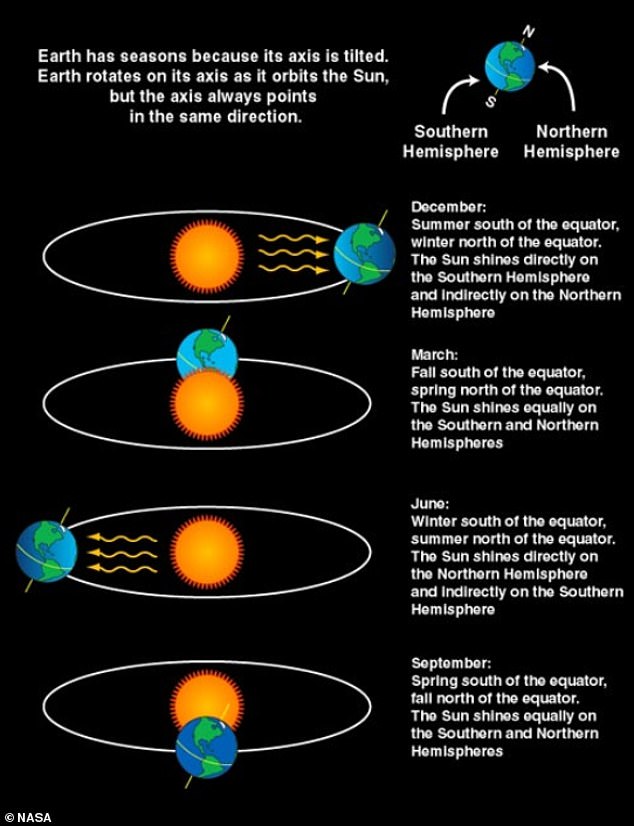
NASA chart explains the difference between the solstice and the equinox. The solstices occur in June and December; the equinoxes occur in March and September
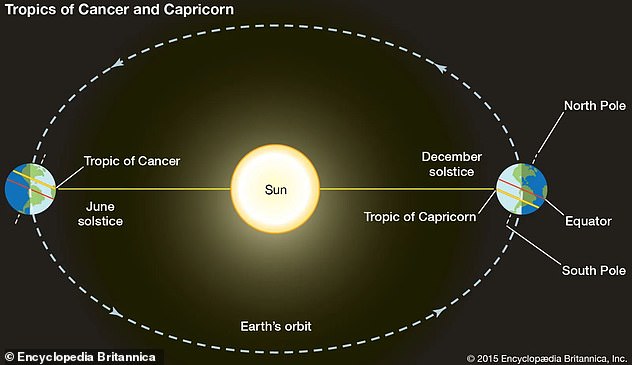
During the summer solstice, the sun will appear directly over the Tropic of Cancer at noon and reach its highest point in the sky
This tilt gives us the cycle of the seasons, marked by the summer and winter solstices and the ‘spring’ and ‘autumn’ equinoxes (when day and night are of equal length).
In 2024, the exact moment of the summer solstice will not occur for at least 228 years.
Mr Foster said: ‘Although the summer solstice often falls on June 21, this is not always a given.
‘Earth’s orbit around the sun does not perfectly align with our calendars, so the solstice can shift between June 20, 21 and 22, depending on the year.’
While our calendars only have 365 days, it actually takes the Earth 365 days, 5 hours and 49 minutes to make its way around the sun, or 365.24219 24-hour days.
This means that our calendars essentially skip a quarter of a day each year, slowly anticipating the actual pattern of the seasons.
To make up for the remaining quarter days, we will of course add an extra day every four years, making it a leap year.
However, adding a leap year still doesn’t quite sync our calendars with Earth’s orbit.
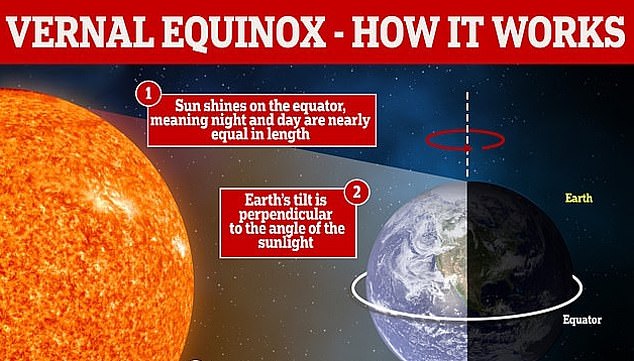
There are two equinoxes every year – in September and March – when the sun shines directly on the equator and the lengths of day and night are almost equal. During equinoxes we experience quite average temperatures and equal lengths of day and night
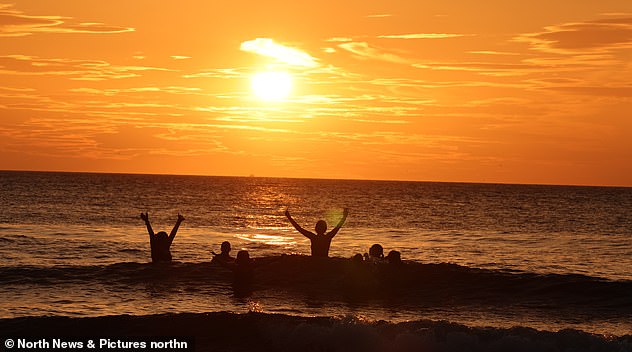
On the day of the summer solstice 2024 – the longest day of the year – people will take to the sea at King Edwards Bay in Tynemouth to celebrate.
By adding an extra day every four years, we pretend that we are losing exactly 0.25 days every year – but in reality we are actually losing 0.24219 days.
While that may not seem like much, those decimals start to add up over decades and our calendars slowly drift out of alignment.
This means that every leap year the solstice occurs 45 minutes earlier.
We correct for this by skipping leap years to century years that are not divisible by 400 – creating 1600 and 2000 leap years, but not 1700, 1800, 1900 or 2100.
This occasionally makes the average length of the day slightly shorter, solving our calendar’s shifting problem, but it only resets every 400 years.
The summer solstice will therefore become earlier and earlier each leap year until the calendar is reset in 2100.
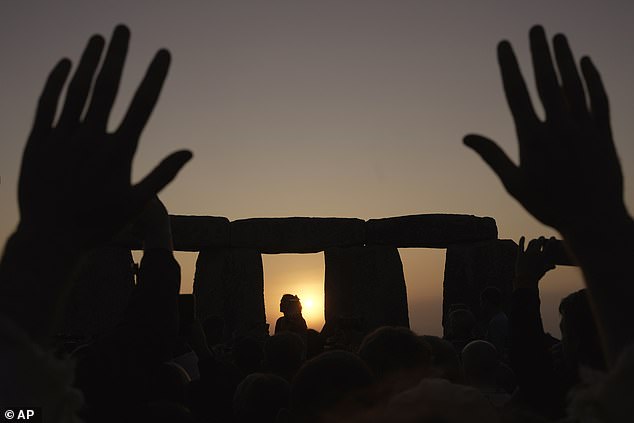
At Stonehenge, modern pagans will gather to watch the sun rise through one of the stone arches. Many believe that Stonehenge was built to reflect the seasons

Midsummer is still celebrated all over the world. Sweden’s floral-themed celebrations were gruesomely showcased in the film Midsommar starring Florence Pugh (pictured)
Around the world, the solstice is marked by celebrations due to its close connection with the progression of the seasons.
At Stonehenge, modern pagans gather to celebrate the celestial event, based on the belief that the ancient stone circle was built to adapt to the seasons.
The rising sun is framed by one of the stone arches on the morning of the solstice, leading many to suggest that it was built as a kind of calendar or place for seasonal worship.
Throughout Britain there are also several Neolithic cemeteries built to be completely illuminated by the light of the rising sun during the solstice.
Elsewhere in the world there is also rich evidence of religious practices surrounding the solstice, as well as many festivals that continue to this day.
At the pyramid of Chichén Itzá in Mexico, for example, exactly on the solstice, a shadow falls on the ancient temple in the shape of the feathered serpent.
And in northern countries like Sweden and Latvia, many flower-themed festivals are still held to celebrate this day.
However, for most people in Britain, the solstice is simply a day to enjoy a little more sunlight than normal.
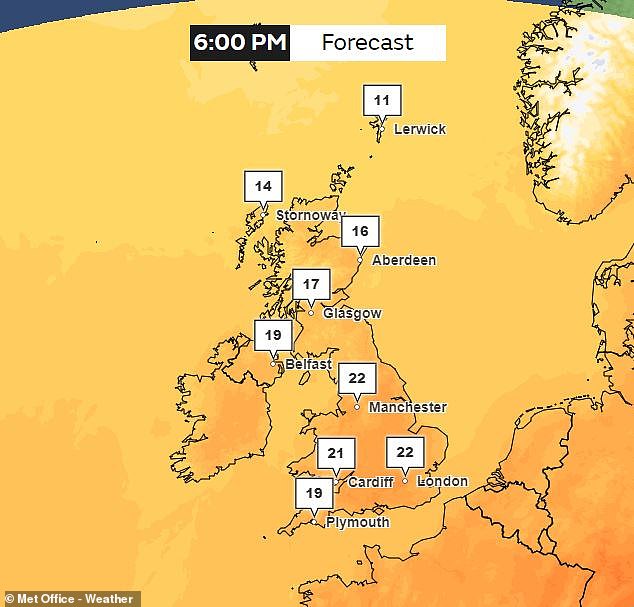
The weather for today will be warm and sunny across most of Britain, but experts say temperatures will warm later due to seasonal slowdown
In London the sun rose at 04:43 this morning and doesn’t set until 21:21, while in John O’Groats the sun rises from 04:02 to 22:25.
But even though it’s the height of astronomical summer, that doesn’t mean the day will actually be warmer.
Mr Foster explains: ‘Despite the summer solstice providing us with the most solar radiation in a single day, the impact on temperatures takes a little longer to become noticeable.
‘This is because it takes time for the Earth’s atmosphere to warm up; the effect is not immediate.
‘We call this ‘seasonal lag’ and it means we experience the highest temperatures later in the summer, once the atmosphere needs some extra time to warm up.’
So while the weather forecast for today predicts mild temperatures across the country, you’ll still have to wait a while before summer reaches its true peak.
It obviously means that after today the days will gradually become shorter, culminating in the winter solstice on December 21 – the shortest day of the year.
